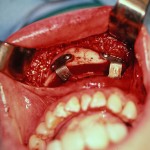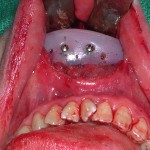The treatment of a short chin is most commonly done with a synthetic implant. When the chin deficiency becomes larger, some plastic surgeons will move the small chin bone forward (osteotomy) to avoid using a larger chin implant. Both approaches are highly successful for chin augmentation and the use of either one is based on the degree of chin shortness, the surgeon’s experience, and the amount of surgery a patient wants to undergo.
In some rare cases of chin deficiency, neither an implant or an osteotomy are completely satisfactory. The magnitude of the chin deficiency may not allow the chin to come close to the most aesthetically ideal horizontal position. The thickness of the chin bone may be less than the chin deficiency or off-the-shelf chin implant options do not have enough thickness. While custom-designed chin/mandibular implants are one option for this problem, the amount of synthetic material needed may not be savory for some patients or their plastic surgeons.
In such cases of large chin deficiencies, the fundamental problem is always that the overall mandible is short. These patients are best treated by orthodontics and subsequent mandibular advancement osteotomies, with or without additional chin augmentation done at the same time. However, some patients do not have the resources for this standard approach or are seen later in life when they are not willing to undergo that multi-year treatment plan.



Dr. Barry Eppley
Indianapolis, Indiana



